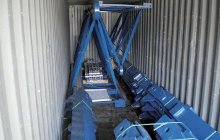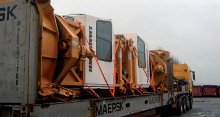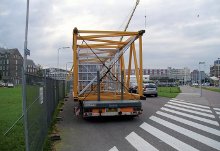In the long haul
16 November 2012Cristina Brooks finds out how the size of crane components can impact on transport costs. At the top end of the market, dealers complain, customers around the world can pay an extra $20,000 to transport oversize parts.
Before opening its Texas branch, Linden Comansa dealer Heede Southeast served clients by hauling its tower cranes hundreds of miles by land from North Carolina.
These days the firm's new Dallas, Texas branch covers not only local work, but also jobs 100mi (160km) away in Oklahoma.
"Recently we've been doing a lot of hospital work and things like that where the contractor flies very large tables. Those are pretty high weight and they are needed at long reach. We also do some power plants and chemical plants,"says Jason Kenna, general manager, Heede Southeast.
"Around Dallas, a lot of our (18t) 21 LC 550s are on a big project, Parkland hospital. It's a brand new hospital we're working on for Balfour Beatty. We have five cranes erected: four 21 LC 550s and one (18t) 21 LC 400."
When Heede Southeast moves towers over distances of 100-150mi, it loads all the tower sections for the transport company before the erection rather than trucking out groups of sections at a time.
"Instead of having three trucks on a local job, a long distance transport will run between nine and 15 loads depending on the height of the tower crane."
Long distance hauls require expert planning as they expose dealers to forces majeures: truck failures or other costly delays.
The risk increases not only with distance, but also with the size and complexity of the loads, because more trucks means more potential for truck breakdowns.
Once on site, obstacles or rough road conditions can prevent transporters, particularly terrain-sensitive lowboys, from reaching the erection area.
There no room for error for the dealer, since delays to even a single truck can stall the erection process, adding worrying costs that have not been quoted to the end user.
Counting costs
Like fellow Linden Comansa dealer Heede Southeast, Portugese dealer Ibergru is careful when it comes to its logistics, arranging a transport company to deliver parts in a precise sequence.
It starts by loading the undercarriage and ends with the counter jib, with Ibergru co-ordinating delivery times, and reaching agreements between client and carrier, to keep the erection times short.
Ibergru's legal and marketing manager Rita Barbosa says that unforeseen problems, occurring when crossing borders, can also pose a danger: "The main challenges for international transportation are the different legislation and customs requirements, and force majeure. In both cases a good relationship with the carrier can save a lot of hassle."
"On the one hand, the carrier is an important aid to clarify the destination requests one must comply with for clearance purposes.
"On the other hand, good communication will speed up processes and provide flexibility to both ends, helping to minimise the impact of force majeure on timetables and to optimise the utilisation of other company and client resources," says Barbosa.
Once the crane has reached the site, Ibergru is still on call to sort out problems, coordinating the timings between the yard preparations and the works at the construction site, avoiding bottlenecks and speeding assembly times.
"The more complex the operation -- i.e. transshipping to smaller trucks in order to pass difficult access points -- the better communication one should have with their carrier," says Barbosa.
While moving its largest cranes, like its 48t 21 LC750, in Europe for jobs such as construction of dams, viaducts, bridges and subways, Ibergru generally uses only trucks.
Vanderspek, based in the Netherlands, transports ultra-large towers more than most. It owns a fleet of 400 relatively new Liebherr towers, 75 of which are large towers over 400tm, which it rents in Holland and Belgium.
Jacco Veldhuizen, sales manager, tower cranes, says, "High capacity cranes are mainly used by contractors that build with prefab concrete or steel elements. This type of building is mainly built in Holland and that's why we have quite a large fleet of high capacity cranes. We see them being used more often in Belgium and France.
"When we rent out large cranes outside Holland and Belgium at the moment it's mainly for power plants.
"For transport in Scandinavia, we use DSV. Where possible, we use one of our regular transporting companies if we have to deliver and erect a tower crane ourselves in Europe. The longer the distance, the more difficulty you have changing transport from ship-to-truck and truck-to-ship."
Costs matter to clients, says Veldhuizen. "For us, it's important to keep costs down for transport in the neighborhood, say Luxembourg or Belgium. It's very important because people really look at the costs and an extra transport truck means an extra €500-1,000 in the price."
Selling used cranes is part of the annual ritual of upgrading the fleet for Vanderspek. Veldhuizen says, "We 'produce used cranes'. We buy new cranes in the factory, and when we get an inquiry we specify the crane the customer needs and we look in our fleet to see if we have it available, and when it will be dismantled if it's on rental contract.
"We sell cranes mainly in Europe and on the Western European front. We also sell to the Czech Republic and sometimes as far as Southeast Asia, Africa.
"When we sell cranes outside of Europe, we put them in containers and then it's important that all the parts are containerisable," says Veldhuizen.
"Liebherr keep dimensions of individual parts of the crane suitable for transport within 40-45ft containers. However, for 400tm tower cranes, the cabin section is too big to fit into a container and a flatbed container is needed."
For certain brands of larger cranes (over 400tm), owners and their trading partners find have they turntables, chassis and climbing cages that are too big to fit in containers when the time comes to ship to buyers overseas.
This varies not only with crane model, but also with the custom elements of the crane that are required to do certain jobs, like added height and optional features.
To ship these oversize parts, they need to use a flat rack which sits on the ship's deck, where parts can protrude from the top and sides.
Using a flat rack can add €10-15,000 ($13-20,000) to the shipping cost paid by the secondhand buyer.
Ralph Breijer is owner of Multi-Crane, a specialist, international trader, located in Alphen aan den Rijn, the Netherlands.
Multi-Crane has years of experience dealing cranes of all types, so they're well aware of the problems certain cranes can pose.
The industry should tackle these problems, he says. "We think that European tower crane manufacturers should design or adapt their models to be fitted into 40ft High Cube containers." "This would significantly reduce the shipping costs for their overseas clients. This will allow them to compete more effectively with the growing number of competitors from other continents."
Making it fit
Manufacturers are designing compact mast sections to decrease loading times and truck dependency. Kenna says, "The beauty of the Linden Comansa crane is the panelised section. They're very easy to load and unload and you can fit more per truck. Typically 11-12 trucks for a tower crane."
Linden Comansa says its transport frame fits 16 mast panels, or four tower sections. "Two of these devices can fit into a container, or truck. So eight mast sections fit into one container, for a tower height of 44m. Other manufactures would need four containers to achieve that height."
Kenna says his company manages loading differently for three classes of towers. "A 300tm crane requires no special loads; we can haul on regular flatbed trailer. For 400-550tm cranes, we require a lowboy for our first piece of jib, which is 14.2ft tall.
"The oversize regulation varies from state-to-state. It states only certain loads for 1 and 2 Class machines are permitted."
The 21 LC 550 comes in three versions: 12, 18 and 24t. The 21 LC 400 comes in two versions: 12 and 18t. For larger versions, low deck trailers may be used. "Most of our haul is done on a 48ft flatbed trailer. Some of our 400 and 500 machines require a drop deck trailer with extendable low deck or a trailer, and that's because the pieces of jib are very tall and they need a permit to haul.
"I know a lot of bridges that are 15ft high, and its also for going under low-lying power lines. A lot of that goes back to the trucking company, and they plan the fastest and most efficient route," says Kenna.
Manufacturers, aware of size constraints, are shrinking parts above the mast. A folding jib is a highlight of Linden Comansa's LC3000 flat-top series. Potain's 16t MDT 368 topless tower, launched in 2009, has a hoist package that can be separated from the counterjib to enable folding the A-frame.
Transport is a focus for Carsten Bohnenkamp, director of sales for special application cranes at Manitowoc. He says containerisability is the future for cranes over 600tm capacity.
Bohnenkamp was previously engineering manager for Manitowoc tower cranes. In that role, he was instrumental in designing the folding counterjib.
Using this feature customers can load MDT 368 towers on normal trucks, while meeting oversize regulations in the US and Europe. A similar feature is available on MDT cranes up to MDT 308 involving the folding of ballast block parts only.
Bohnenkamp says, "As soon as mast section dimensions exceed 2.5m, you need a special permit to transport the part. All the mast types of Potain, from 1.2m up to 5.5m of square section exist as so called 'panel masts'. All these can be transported in containers and so respect the 2.5m limit."
Options that improve transport, such as panelisation, are available across all Potain ranges, but customer preference and the specifics of jobs mean that some clients choose monoblock.
"For an MD1100 the number of trucks depends on the height and jib length. It can range between 20-50 trucks," says Bohnenkamp.
Manitowoc is also designing for ease of transport overseas. The MDT 368 is a fully containerisable Potain. MD range cranes under 600tm are wholly containerisable, being able to ship overseas in 20 or 40ft containers.
On the other hand, on MD towers above 600tm, some components are containerised in special containers like open tops. This is to promote structural soundness and based on years of fatigue testing, says Bohnenkamp.
"In some cases the decisions to not split a piece further are ground rules and based on our 85 years experience," he says. Tough jobs require cranes with maximum fatigue resistance: working on a bridge in Vladivostok Russia, a 40t MD1100 reached 335m in height. Its panelised mast sections were all shipped overseas with two mast sections of 5.78m length each in a 40ft container.
Tekno is Potain's exclusive dealer in Turkey. It provides not only tower crane rental but also produces energy and asphalt.
Tekno says: "Potain has always had the easiest possible transport as central to production. This allows even the very big components of the crane to be delivered on standard means of transportation, such as 40ft high cube containers, 40ft flat rack containers and standard trucks. For the oversize monoblock components of cranes such as the MD 2200, we need low bed trucks."
Manufacturer Terex's cranes have been fully containerisable for over a decade says Mauro Ragogna, traffic manager, Terex Cranes: "For all models of Terex tower cranes, including our big models such as CTT 721 or CTL 650, we do not need special equipment to ship worldwide. All parts may be shipped in a 40ft container or a high cube with maximum of four tower sections in a container."
Terex says that ten years ago it designed its cranes not to use open top containers any more, although ease of transport has always been a priority.
"There are some parts that need special equipment to be shipped, but we are talking about only special application engineering. For example, in ports they need special rail-traveling chassis custom-built for them, and for these special parts they need a low trailer.
"For shipping a tower on land, you need an average of 5 trucks for the upper part plus a variable number for the tower sections, this of course depends on the crane's height configuration. So if it's 40m or 80m high is one issue, if is higher it is another."
While Terex's HD33 and HD45 sections can be panellised, not all Terex users choose the panelisation option, Ragogna says.
"You always have to balance the convenience of transport versus the assembly or disassembly time, and of course never compromise on safety."



